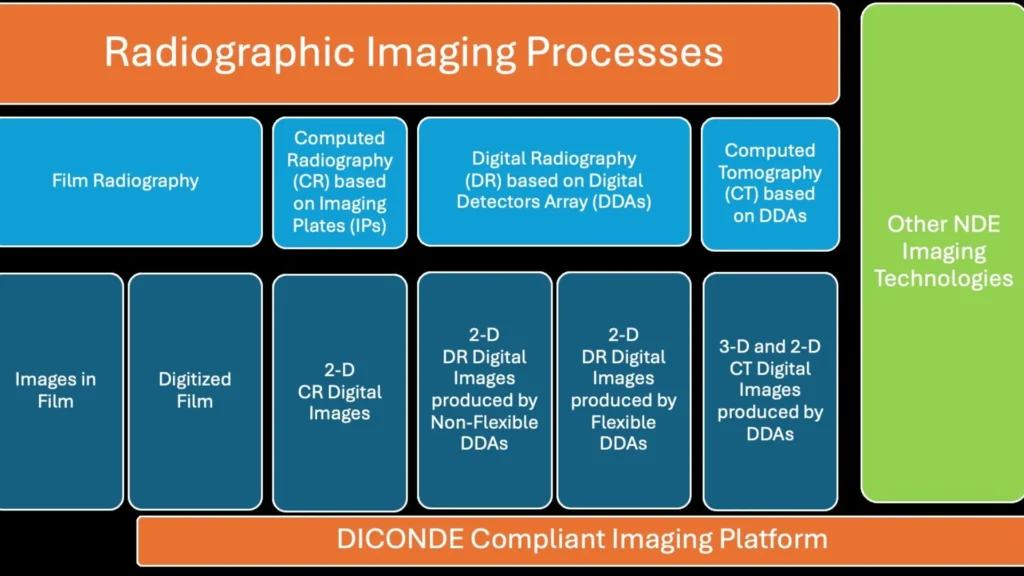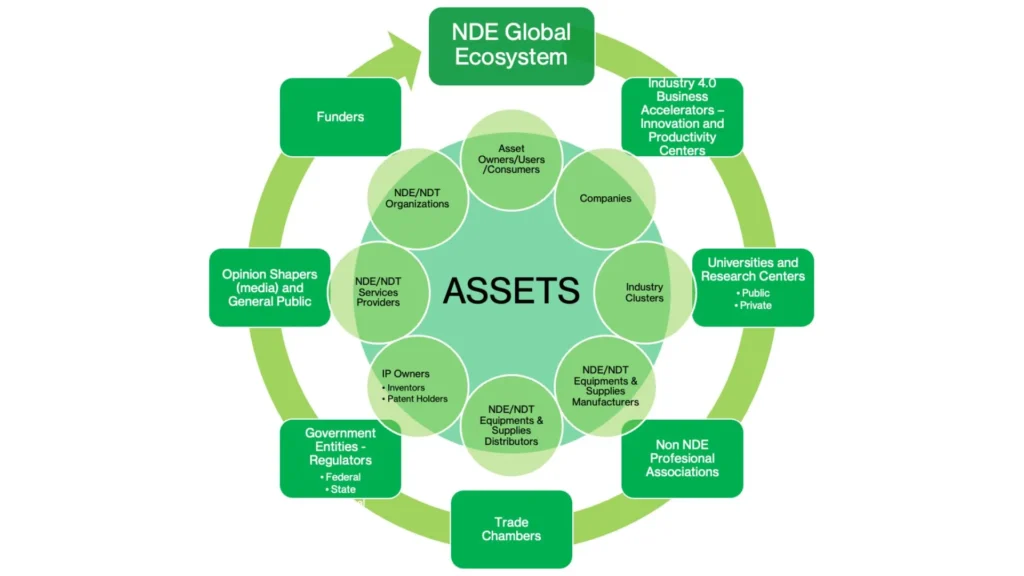By Brian S. White. Textual note taken from Carestream NDT dated June 27, 2024
Introduction – A Business Ecosystem for your imaging processes
It will be important to you, in order to advance your radiographic competencies, to generate a transformative mindset based on an expanded perspective of the imaging processes applicable to your professional activities within the context of an expanded ecosystem perspective .
Figure 1 shows a basic perspective of the technological portfolio associated with the radiographic imaging process within the context of an expanded NDE imaging ecosystem.

Please notice in the diagram that a DICONDE-compliant imaging platform constitutes a transversal axis that binds together those different imaging technologies. DICONDE is a vendor-neutral digital data storage and transmission protocol that defines the organization of NDE image data and associated metadata in a standard electronic format.
What is a Business Ecosystem?
Demil, Lecocq, and Warnier in [1] define a business ecosystem following a biological analogy “as a community of interconnected heterogeneous actors with complementary competencies and participating in a value-creation process. This process requires the management of interdependencies between actors, eventually orchestrated by a leading organization and a balance between cooperation and competition among actors. This view maintains that ecosystem differs fundamentally from the concept of environment. Another characteristic of an ecosystem is what it encompasses. Indeed, it does not comprise only heterogeneous actors but also technologies, regulations or physical infrastructures. A typical example of this can be found in the recent development of digital platforms connecting multiple stakeholders by offering a technological interface..”
The notion of complementary competencies will be the focus of the second part of this article and here we will center on three key ideas derived from this definition: 1) a community of interconnected heterogeneous actors, 2) participating in a value-creation process, and 3) the development of digital platforms connecting multiple stakeholders by offering a technological interface.
The constituents of the NDE Global Business Ecosystem
Figure 2 shows in detail the interconnectedness between all the heterogeneous actors that constitute the NDE Global Ecosystem, as is described by Singh, Fernandez, and Vrana in [3].

The ecosystem diagram shows a kernel of core stakeholders with a direct impact on the quality, reliability, and safety of assets. It also shows in its exterior a network of support stakeholders for the constituents of the core that enables them to accomplish their purpose and to create substantial value not only for specific ecosystem’s constituents bit also to humankind in general. Think about how these constituents might influence your work. How might you maximize your professional opportunities?
Conclusions – The impact of platforms in your imaging ecosystem.
As we expressed at the beginning of this article, it will be important for you as an NDE practitioner:
1) To consciously integrate into your everyday mindset not only the synergetic interconnectedness of NDE imaging technologies in general and radiographic imaging technologies in particular, but also how this constructive interaction develops within a constantly evolving global NDE ecosystem.
2) The assimilate the profound impact of digital platforms in every aspect of your professional and personal life and why vendor-neutral digital data storage and transmission protocols should be at the core of imaging platforms.
If you are interested on expanding and enhancing your film-based radiographic imaging process or if you want to explore how digital radiography (DR) or computed radiography (CR) can be integrated into your everyday operations we encourage you to explore our imaging technological portfolio in the following link: https://www.carestream.com/en/us/nondestructive-testing-ndt-solutions
If you are particularly interested in obtaining more information related to our DICONDE-compliant digital viewing software you can find more information here:
https://www.carestream.com/en/us/nondestructive-testing-ndt-solutions/carestream-industrex-digital-viewing-software
Your comments about this content are welcomed.
References:
- Demil, Benoît, Xavier Lecocq, and Vanessa Warnier. ““Business model thinking”, business ecosystems and platforms: the new perspective on the environment of the organization.” M@n@gement 21, no. 4 (2018): 1213-1228.
- Fernandez R., Hayes K., and Gayosso F.. (2021) Artificial Intelligence and NDE Competencies. In: Meyendorf N., Ida N., Singh R., Vrana J. (eds) Handbook of Nondestructive Evaluation 4.0. Springer, Cham.
- Singh, Ripi, Ramon Salvador Fernandez, and Johannes Vrana. “Guideline for the Development of an NDE 4.0 Roadmap.” Journal of Non-Destructive Testing and Evaluation (JNDE) 20, no. 4 (2023): 23-41.
Don’t miss any of our posts and follow us on social media!
YouTube LinkedIn Facebook Instagram
Source: www.carestream.com

